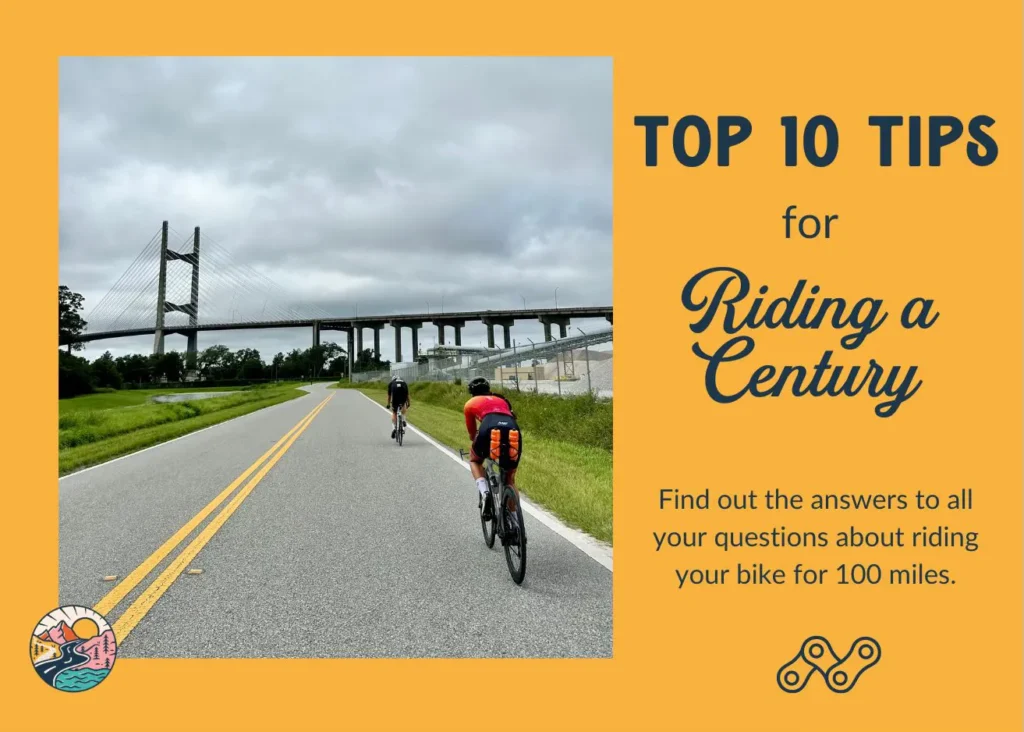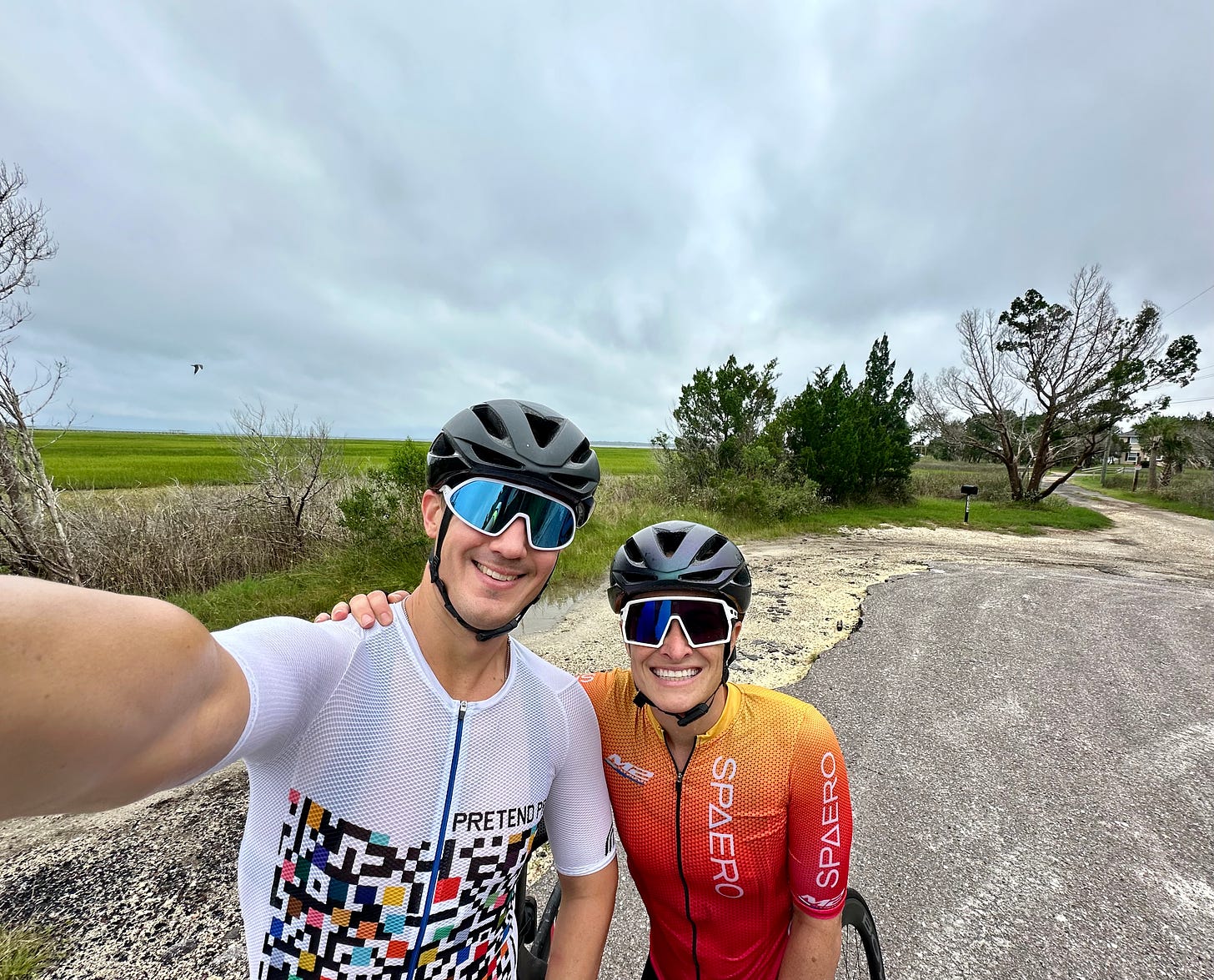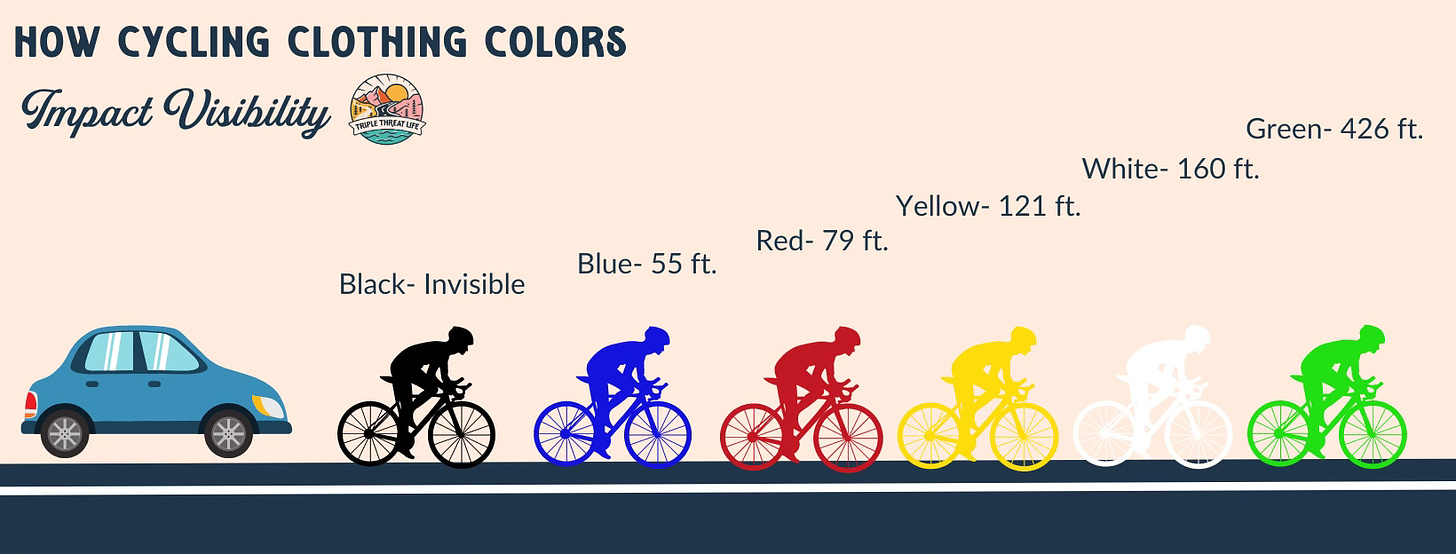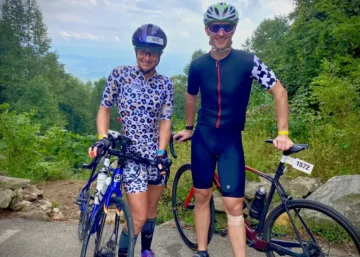
Do a century by the beach, they said.
It will be fun, they said.
They lied.
Sometimes in triathlon training, the joy is found more in the completion than the actual doing. That was definitely the case with this century by the sea!
We encountered:
- 20 mph wind
- pelting rain
- cars
- roads with no shoulder
- a lot more cars
- almost got hit by two different buzzards (no idea how this happened.)
- Mr. Toad’s Wild Ride through a windy, forest trail
- super sketchy wooden bridge
- bridges with concrete barrier and no shoulder

But the coup de grace was the last 10 miles, riding into a 20 mph headwind with rain, cars spraying water, and trucks pumping out water from flooded beach houses onto the road.
It was special.
The only redeeming quality was that it was an excellent mental strength building experience.
But riding a century even on the best of days can be a challenge. I mean you’re covering 100 miles, on a bicycle! Crazy right?
- That’s like crossing the Grand Canyon 18 times.
- Climbing Mount Everest more than 3 times.
- Covering the length of 1,760 football fields.
It’s also an incredible accomplishment and can be a transformative experience. So for those of you crazy enough to attempt a 100-mile bike ride, read on for our top ten tips for your next century ride.
Top Ten Tips For Riding a Century
I remember doing my first century ride back in 2020. Since then, I’ve ridden 7 centuries. Kind of hard to believe!
Some have been flat and fast with no elevation, while some have been mountainous with 12,000+ ft. elevation. I’ve ridden some on my triathlon bike, and I’ve ridden some on a road bike.
I even met my husband while riding a century, but that’s a story for another time. 😉
While each experience is unique, there are some best practices to make sure you can cover the 100 miles as efficiently, and enjoyably, as possible.
1. Wear the right clothing
One of the most important things to keep in mind when preparing to ride a century is realizing that you’ll probably be on your bike for at least 5 hours. We’ll get into exactly how long it takes to ride a century a bit later, but just know that you’re going to be out in the elements, and on your bike saddle, for a long time.
Comfort and efficiency is key when riding a century, and although clothing choice will depend on weather conditions, there are a few things to keep in mind.
You can either wear cycling bibs (our pick) or tri shorts. Know that tri shorts have no padding, while cycling bibs do. Some cycling jerseys have perforated, lightweight fabric, which makes them more breathable, and they have back pockets for holding snacks.
Whatever you wear, make sure it fits properly. Cycling clothes should fit snugly to the body. Anything that’s loose will cause rubbing and chafing. Not fun.
Chamois cream is your friend, especially on long rides. Also, in Florida it’s very sunny, so we wear sunscreen and bring extra to reapply. Zealios has single-serve packs of chamois cream and sunscreen that are very small and fit in your jersey pocket. Super handy.
*TIP- No matter what you wear, if your bike doesn’t fit you properly, no amount of chamois cream will fix chafing from an ill-fitting saddle. A bike fit with a reputable bike fitter is the best investment you can make. They can make adjustments to prevent an achy back, sore neck, and numb hands.
Have you ever considered that what you wear impacts your safety as a cyclist? Check out the graphic below to see how different colored clothing impacts your visibility to cars.

For more information about what to wear in different weather conditions, check out Cycling Essentials 101.
2. Ride smart
No matter where you ride, the fact that you have to cover 100 miles means that you will encounter intersections, stop signs, and cars at some point on your route. As a result, we have a few “non-negotiables” to stay safe.
Have a working taillight. We like the Garmin Radar Varia, because it provides visual and audible alerts for cars up to 153 yards away. It connects to your bike computer or a cellphone and will notify you when a car is approaching from behind. For just $180, it’s one of the best investments you can make as a cyclist.
In addition to a taillight, be sure to bring a cellphone, some cash, and a tire change kit with a spare tube, CO2 cartridge and adapter, and tire levers.
We also wear Road iD on our watches. It’s a small tag that has our emergency contact information.
As far as basic safety tips, ride on the shoulder on the right side of the road. If you’re riding in a group of cyclists, pass on the left, never the right. Don’t overlap wheels or ride too close to the rider in front of you. Use hand signals and verbal cues to indicate debris as well as when you’re turning and stopping. Watch blind corners for cars and other bikes.
Ride defensively. Don’t assume that someone driving a car will do the right thing.
When it comes to navigating intersections and stop signs, a friend of mine shared this great analogy.
“Pretend that you’re driving a tractor-trailer with everyone you love, all your friends and family, inside. That should help you make a decision on whether to roll through or just wait.”
For more safety tips, check out: Complete Guide to Group Rides For Beginners
3. Consider how long it will take
Remember, the horrifying century I talked about at the start? It took us 5 hours and 30 minutes to complete. We’ve also ridden a 6:30 century and a 5:18 century.
The time it takes to ride 100 miles depends on a few factors, including weather, terrain, experience level, and intended purpose.
For example, we rode this century as part of our Ironman training, so the intention is to get off the bike and run a marathon. If you’re solely riding a century, you might be able to do it in less time. If you’re riding in a group where you can take advantage of drafting, it will also be faster than riding a solo century.
If it’s your first century, don’t place any expectations on time. It will take how long it takes. But you do need to consider how long it will take you to cover 100 miles so you can plan how much hydration and nutrition to carry.
Take a look at this table for a few estimates.
Average Speed- Time to Complete 100 Miles
- 20 mph- 5 hours
- 19 mph- 5 hours 16 minutes
- 18 mph- 5 hours 33 minutes
- 17 mph- 5 hours 53 minutes
- 16 mph- 6 hours 15 minutes
- 15 mph- 6 hours 40 minutes
4. Plan your nutrition
Hydration and nutrition needs vary widely among athletes. For example, I take in 60g carbs per hour on the bike, while Matt prefers 90g carbs. I can drink up to two 20 oz. bottles in an hour, while he can drink one.
If you’re preparing for your first century, hopefully you’ve done a few long rides (3 hours) so you will have a pretty good idea of your hydration and nutrition needs.
You will need a well-thought out plan for how much you plan to drink and eat per houron the bike. Also, you’ll probably stop at a gas station or DIY aid station to refill bottles, so bring along extra carb mix in a plastic bag and more gels, chews, waffles than you think you need.
It’s always better to have extra and not need it than not have enough and suffer a dreaded bonk (ie. depleted energy sources, feeling like crap)
If you ride a supported century, there will be aid stations that make the process of refueling easier. But if you’re training for an Ironman, it’s important to consider how you will carry everything you need for the race.
Some people eat solid food on the bike, but we prefer liquid only- carb mix and gels. It’s personal preference, but keep in mind this isn’t a rolling buffet. Eating too much fat, protein, or hard to digest food can lead to a less than desirable result…
TIP: I have an internal timer where I try to drink every 10-15 minutes, just a few sips, even if I don’t feel thirsty. By the time you’re thirsty, you’ve already dug a hole that you might not be able to get out of.
5. Create a route
This past weekend, we rode a supported century, so the route was planned for us. Unfortunately, the route took us on roads and over bridges with a lot of traffic and no shoulder, which isn’t very safe.
When planning a century route at home, Matt likes using RideWithGPS. It’s an excellent website that allows you to search for routes in your area. You can also create your own route and upload it to your bike computer for easy navigation.
We always stick to safe roads that have a shoulder and low car traffic. Luckily, we live in an area with some amazing, secluded roads, but it’s hard to get in 100 miles without crossing into busier areas.
If we’re training for a 70.3 or Ironman, we look at the elevation profile to find something that mimics the race course. Also, we consider what type of workout we have planned. If we have race type efforts with higher power, we might stick to a flatter route and save the climbing for another day.
When planning a route, we think about the timeline for when we will need to refill bottles. We design a route around water fountains or gas stations. Sometimes, we use the truck as a DIY aid station and keep a cooler with our extra bottles in the back.
*TIP: Riding shorter loops is a great way to include other cyclists in on the fun by letting them join you for 40, 50, or 60 miles of your century.
6. Master the art of the rest stop
When riding 100 miles, some rest stops are inevitable in order to replenish nutrition (unless you’re a camel). But make them short and sweet.
Don’t remove cycling clothing, take a nap, call your mom, ect. Get the hydration and nutrition you need, take a quick bathroom stop if necessary, and get back on the road.
Stopping for too long causes your muscles to seize up, and it’s hard to get moving again. One time we were riding with a large group and later looked at our “idle time.” It was 1 hour and 30 minutes! That’s crazy and totally unnecessary. Who wants to make a 5 hour ride last 6 hours?
7. Consider how weather will impact your ride
The weather can impact your century ride in a variety of ways. For example, if it’s a hot day, you might need to take in more hydration than you’re used to as the ride goes on.
You’ll probably encounter wind at some point. Whether it’s tailwind, headwind, or crosswind, this all has an effect on the body’s ability to cool itself, pacing, and how long the ride will take- all factors that affect your hydration and nutrition strategy.
Tailwind– Awesome! Very fun. You can ride faster for less effort.
Headwind– Ugh. Not as fun. Don’t get frustrated. Increase your cadence and try not to muscle through it.
Crosswind– Tricky. Not fun with race wheels. Be extra careful with distance in between riders and watch for bursts that can blow you across the road.
We also take into account sunrise to determine our start time, because we want to get started as soon as possible. Not only does it get you a head start before it gets too hot, roads tend to get busier as the day goes on.
You can ride in rain (as evident from this past weekend) but lightning is never a good idea. Summer showers pop up in Florida all the time, so it’s hard to avoid them completely, but we do keep an eye on weather patterns to make sure we aren’t riding in a storm.
TIP: When riding in the rain, be careful of road lines because they can get a bit slick. Also, maintain more space in between riders because brakes will be slower to respond.
8. Keep an eye on pacing.
Theoretically, you should have an idea of a comfortable pace you can maintain for a 2-3 hour ride, so you can extrapolate this out for 5+ hours. If you don’t, ask yourself this question.
Can I sustain this current effort for 5+ hours?
Resist the urge to “put time in the bank” by riding harder during the first 20-30 miles of a century. This plan rarely ends well…
If you feel awesome by mile 90, then by all means hammer to 100. But it takes a long time to get to 90, so ride smart, especially if it’s your first century.
Maintaining a consistent pace is the best strategy. That doesn’t necessarily mean riding slow, or riding fast. It means whatever is a comfortable and consistent pace for you.
Also, keep in mind that if you’re riding in a group and have the ability to draft, your effort level will be lower than when riding solo. However, you have to ride your own ride. If you join a group, make sure you’re clear about the expectations for pace, up front.
TIP: If you want to join in on a century with people who are training for an Ironman, that’s great! But remember that their pace goes. Don’t push the pace because you want to ride faster, and don’t make them wait, because you can’t keep up.
9. Use the strongest muscle in your body
No, I’m not talking about your glutes (although those are helpful too) I mean your brain. There will likely be a point during a century ride when you have one, if not all, of these thoughts.
- “This is stupid. Why am I doing this?”
- “I’m tired, hungry, and want to go home.”
- “Send help please.”
Nobody said riding 100 miles on a bike is going to be easy. But that’s not why you want to do it, right?
You want to ride a century to push your limits, see what you’re capable of, and have an amazing experience. When you reach that point of feeling tired, cranky, or just done, first thing is check on your nutrition intake.
How are you doing taking in carbs, electrolytes, and fluid?
Next, assess your effort level.
Have you been riding too hard? Is your cadence too low? Is your heart rate too high?
Be smart and make adjustments, because you’re on the bike for a long time. If something is bothering you, fix it early on because the likelihood it will just get better without addressing the problem is slim to none.
Sometimes, you will need to rely on your mental skillset to get you through. Reframe negative thoughts by focusing on three good things you can list about your ride.
TIP: Do NOT look at the mile countdown. The distance from 80-100 will take an eternity if you watch the miles tick off one at a time.
Riding with friends helps a lot. Chances are, someone might be feeling the same way you are, or has been there at some point. Don’t be afraid to ask for help or advice.
10. Recover like a champ
There’s understandably going to be some fatigue that will set in after riding 100 miles on a bike. Therefore, it’s crucial to take in carbs and protein as soon as you can post-ride.
We like to keep protein powder in shaker bottles in the truck. Then, we fill them up with water and drink them on the ride home. Once we’re at home, we have a full meal. This gets you a quick start on the recovery process.
Also, never ride home in wet cycling clothes. That’s a good way to get saddle sores and infections. Bring a change of clean, dry clothes for the ride home.
If it’s your first century, you might be a bit sore or tired for a day or two afterwards. Epsom salt baths, compression boots, walking, or doing an easy spin to help flush out muscles can help.
Keep in mind that some fatigue might show up later in the week, so be patient if it takes you time to rebound and get back to regular training.
Whether it’s your first century, or your 10th century, I hope some of these tips will help you have a more enjoyable experience riding your bike for 100 miles!
If you have any questions for me or Matt, send them over and we will answer them in a future post as our Question of the Day.


